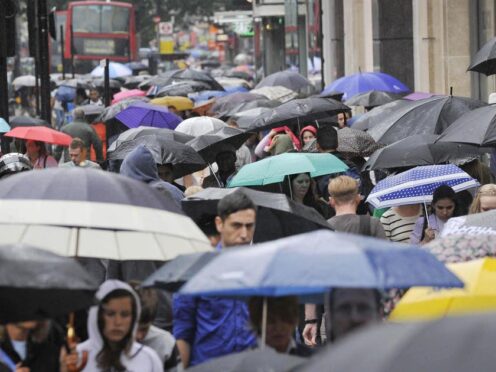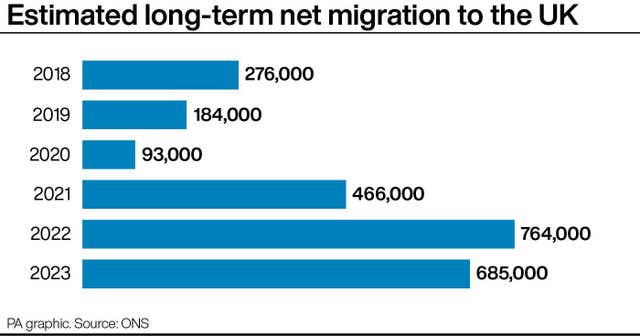
Net migration to the UK dropped by 10% last year after hitting a new record of 764,000 in 2022, revised official estimates show.
The latest figures, published a day after the General Election was called, are likely to feed the immigration debate – expected to be a key campaign battleground.
Revised estimates from the Office for National Statistics (ONS) put net migration to the UK in the year to December 2022 higher than previously thought. However, the figure for the year to December 2023 is estimated to be lower, at 685,000.

The ONS said it is too early to tell if this is the start of a new downward trend but that the most recent estimates indicate the number of people coming to the UK is slowing while those leaving is rising.
Work was the biggest driver of migration in 2023, overtaking study, and there was a substantial increase in the number of people arriving from outside the EU on work-related visas, the figures suggest.
The measure – which is the difference between the number of people arriving and leaving the country – has been revised upwards by 19,000 for 2022 from an earlier estimate of 745,000 now that more complete data for the year is available.
Some 1.22 million people are estimated to have arrived in the UK in 2023 (immigration), while 532,000 are likely to have left (emigration). This is compared with 1.26 million and 493,000 respectively in 2022.
The rise in the number of people emigrating from the UK long-term has been driven largely by increased emigration from non-EU nationals, particularly among those who initially arrived on a study visa, the ONS said.
The figures precede a raft of restrictions brought in by the Government since the start of 2024 amid pressure to cut the record number of people legally arriving in Britain.
We've published provisional long-term international migration estimates, UK, year ending December 2023.
• Immigration was 1.2m• Emigration was 532,000• Provisional net migration (difference between people arriving and people leaving) was 685,000
➡️ https://t.co/klL8ga1u1x pic.twitter.com/qdQPBAsGf7
— Office for National Statistics (ONS) (@ONS) May 23, 2024
The Home Office stressed the estimates “do not take into account the major package measures announced in December which have already started to have an effect”.
The estimates show that non-EU immigration for work-related reasons increased from 277,000 in the year to December 2022 to 423,000 in the year to December 2023, replacing study as the main reason for long-term migration.
More than four out of 10 people moving to the UK for work-related reasons last year came from India or Nigeria, most commonly in the health and social care sector.
The number of non-EU nationals arriving as dependants of those on long-term work visas was higher last year than the number of main applicants, at 219,000 and 204,000 respectively.
Levels of net migration to the UK have varied sharply in recent years.
The figure was on a downwards trend immediately before the Covid-19 pandemic, falling from an estimated 276,000 in 2018 to 184,000 in 2019.
It dropped to an estimated 93,000 in 2020, when restrictions introduced during the pandemic limited travel and movement.
The total then rose to 466,000 in 2021, before jumping further to a record 764,000 in 2022.
The most recent estimate of 685,000 for 2023, suggests levels are starting to fall once again, although “it is too early to say if this is the start of a new downward trend,” the ONS said.

Enjoy the convenience of having The Sunday Post delivered as a digital ePaper straight to your smartphone, tablet or computer.
Subscribe for only £5.49 a month and enjoy all the benefits of the printed paper as a digital replica.
Subscribe